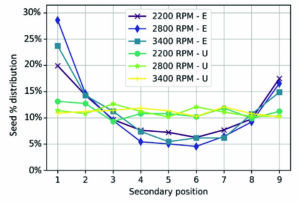How to improve seed distribution with air drills
KEY RESULT:
Replace damaged or kinked air drill hoses immediately, and replace with the same length and diameter as the original. This is key to consistent air flow.
PROJECT TITLE, PRINCIPAL INVESTIGATORS:
“Understanding grain pneumatic conveying in seeding equipment,” Hubert Landry, Ian Paulson, and Samuel Ferré, Prairie Agricultural Machinery Institute
FUNDING:
SaskCanola, Government of Manitoba under the Canadian Agricultural Partnership Prairie Agricultural Machinery Institute
PUBLISHED ARTICLES:
Read the full report in the Research section
at saskcanola.com.
This three-year project measured air drill distribution performance, both in the laboratory and at field-scale, and simulated various configurations of pneumatic conveying systems.
The first objective was to determine the effect of air velocities, air hose lengths and routing geometries, and/or tool bar angles on the seed distribution coefficient of variance (CV) and germination of canola. Another objective was to develop and validate numerical models to track machine-seed interactions in the pneumatic conveying system.
Researchers tested a full-scale pneumatic seeding system to quantify seed damage, seed distribution consistency, and air flow behaviour. Air flow measurements were taken with and without seed being conveyed. Three different fan speed treatments were used, 2,200, 2,800, and 3,400 RPM. Seed germination was also measured after the experiments were completed to characterize possible germination effects from pneumatic conveying; samples were grouped by distributor and fan speed treatment.
Finally, numerical models were developed to predict both the airflow behaviour and the seed distribution performance of several configurations of pneumatic conveying systems.

Results
The project highlighted the importance of simple but careful maintenance of air drill pneumatic conveying components and systems.
Recommendations include:
- Replace secondary hoses with hoses of the same length and diameter as the original to maintain consistency. This is important to system performance. If replaced with a longer hose, these secondary hoses tended to receive less seed in both measured and simulated datasets. Also maintain downward flow.
- Follow the manufacturer suggested hose routings unless actual performance data suggests otherwise.
- Severe bends should be minimized in both primary and secondary hoses wherever possible, and avoid introducing sharp bends close to the entry of a J-tube elbow when replacing primary hoses.
- Replace damaged or kinked hoses immediately and use the hose fastening/restraint schemes suggested by manufacturers.
Results also showed that using the manufacturer-suggested fan speed provided the most consistent distribution of seed across the air drill. Increased fan speed reduced distribution consistency. The coefficient of variation across the whole drill increased from 11.0 per cent at the lowest fan speed tested to 12.5 per cent at the highest fan speed. Interestingly, air and speed distribution patterns differed from each other (i.e. more air through a given secondary hose did not guarantee more seed).
Full-scale testing of pneumatic conveying of canola seed through the air drill did not result in a reduction in germination from the control sample (seed that didn’t go through the drill), and no variations in samples taken across the air drill were evident.





